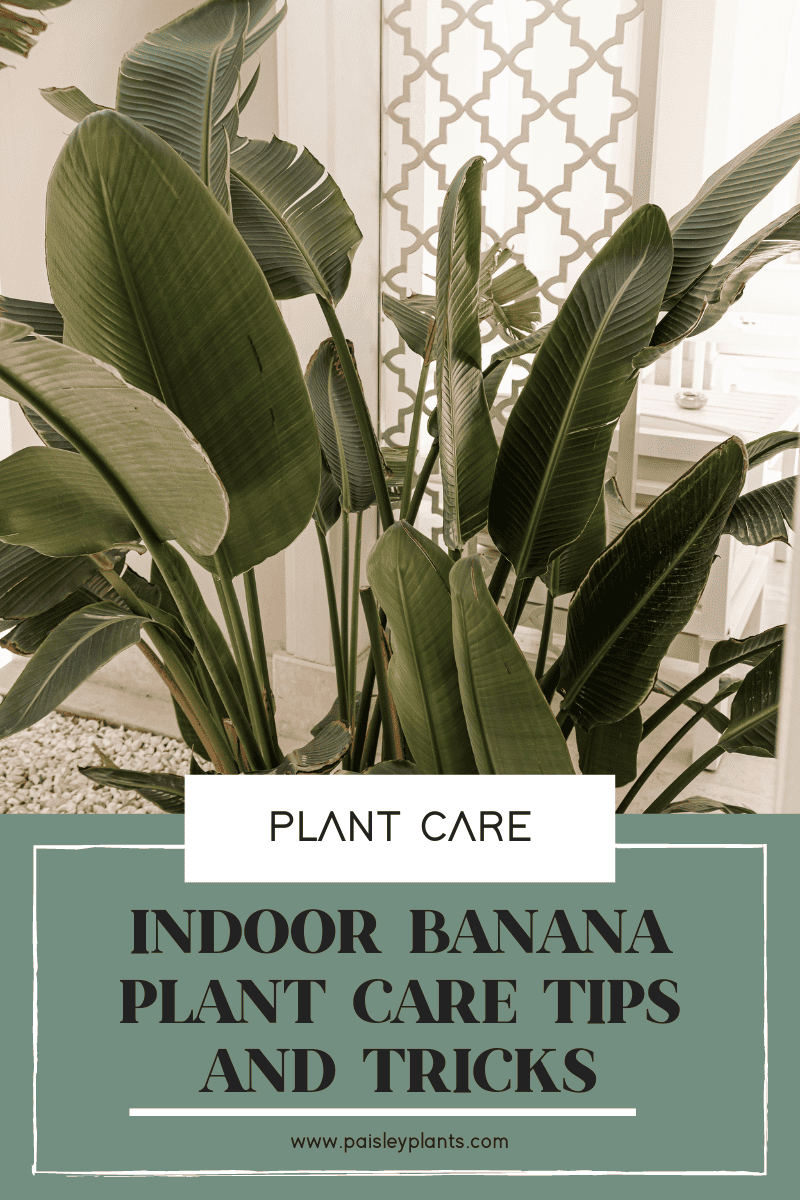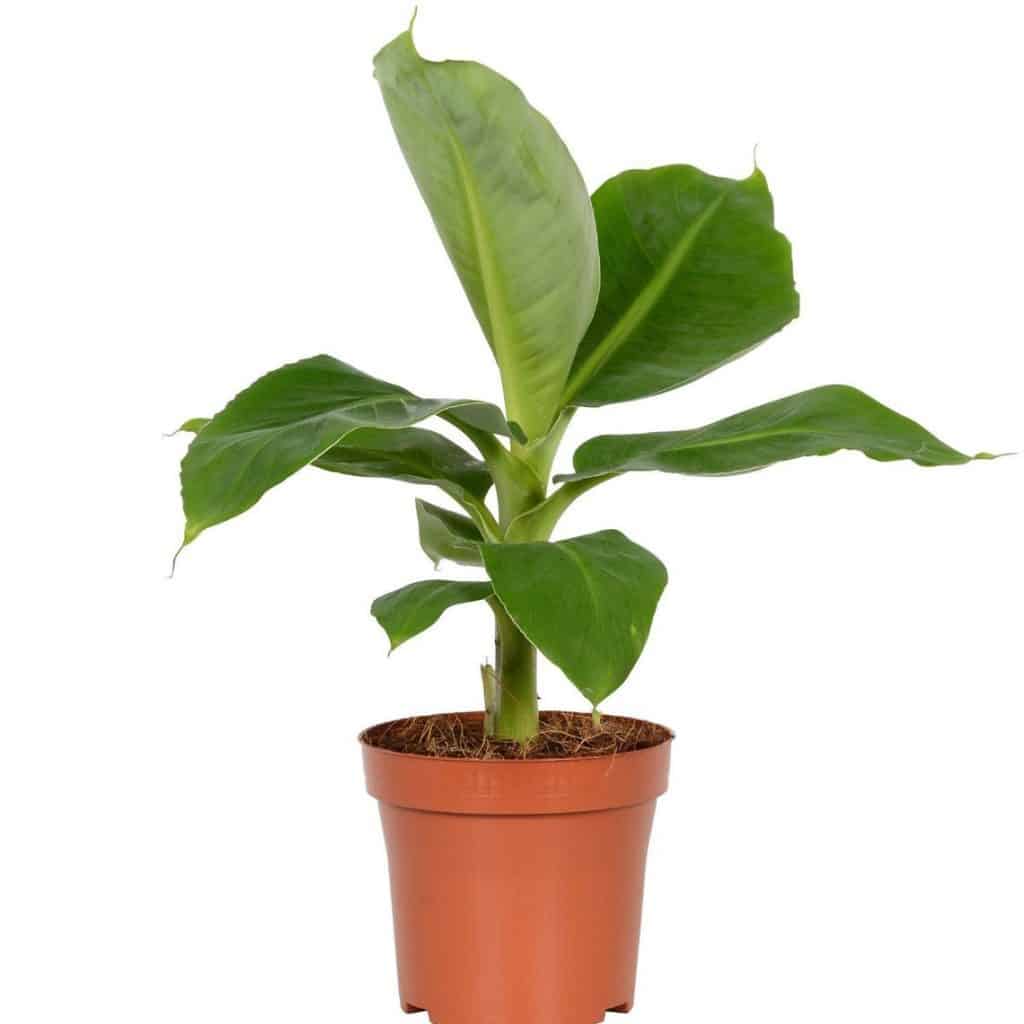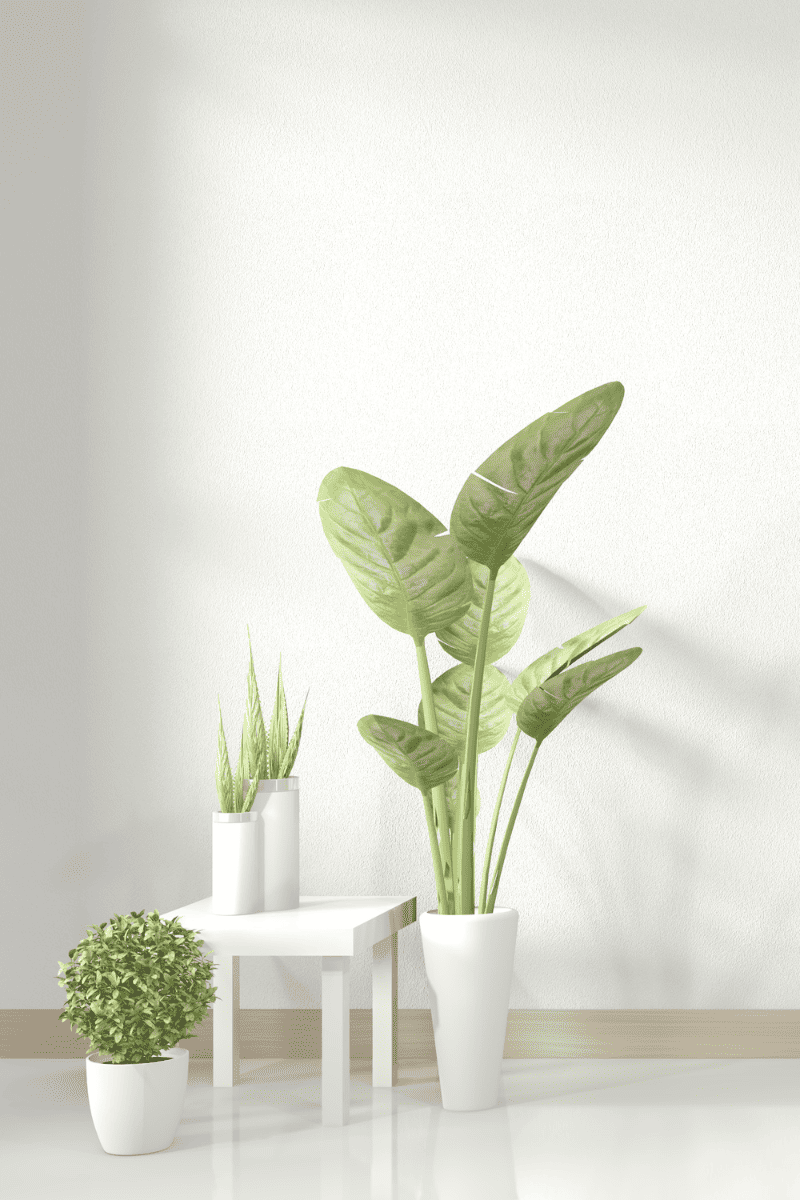Most likely when you think of a Banana Plant, you think of one that grows in the jungle. However, they can also be grown indoors with the right kind of care.
They are actually fast-growing perennial herbs that can reach up to 20 feet tall in the wild. They have large, oval leaves and produce clusters of red, yellow or purple flowers. The
The edible fruit of the banana plant is an elongated, yellow berry with many berries. It is commonly known as the bananas we eat either alone or on top of cereal or an ice cream sundae!

Table of Contents
Banana Tree Background
These plants are native to Southeast Asia. The scientific name for a banana is Musa. This comes from the Musaceae family of flowering tropical plants, which has the distinctive banana fruit that clusters at the top of the plant. There are a variety of different banana trees. Here’s a few of them:
- Musa basjoo – This fast growing herbaceous perennial is known as the Japanase banana.
- Musa ornata – Also knows as Pink Serpent, this plant grows seeded inedible bananas.
- Musa acuminata – This species has paddle shaped leaves and grows Cavendish bananas – ones that. you would find at your local grocery store!
Some of the common names for the Banana Plant are Banana Leaf Plants, Platana, Banana Tree, Manzana, and Cavendish. They are also called a Banana Palm.
As herbaceous perennials, these plants don’t have a woody stem like you would typically see in a plant called a “tree”.
They’re known by their large leaves that, if not protected from the elements such as strong winds, can become shredded easily when grown outdoors.
Toxicity
Because the Banana plant is about 93% water, it is not toxic. Your animals may find their way to your Banana plant and lick around the stem, but the good news is that if they do, it won’t harm them! These plants are not toxic to animals or humans.
Banana Plant Care
With proper care your banana plant care grow healthy and happy. Here’s all the banana tree care tips you need to know!

Photo via American Plants on Etsy
Watering Requirements
Your indoor Banana Plants need to be watered on a regular schedule. It requires even moisture and does well when you keep it together with a group of other plants to maintain the moisture level. You want to be sure it has moist soil, but not soggy, to prevent root rot.
Fore best results, be sure to use a pot with drainage holes and well-draining soil so there is never standing water in your pot. Too much water is detrimental to this plant. It is also important to maintain the soil moisture so the leaves of the plant keep an even moisture level.
Light Requirements
Banana Plants need full sun to thrive. This will mean that you will need to have your plant in at least six to eight hours of direct sunlight per day. Keep your Banana Plant near a south facing window and you might even want to consider using a grow light to supplement the light source.
One other thing to consider is that you will want to be sure to rotate your pot on a regular basis so that the plant does not grow unevenly. This will become evident if the leaves start growing toward the light source.
Soil Requirements
Your Banana Plant will thrive in well-drained soil. You should consider using a mix of peat, perlite, and vermiculite. There is also a good cactus or palm tree soil mixture available for use since this is a tropical plant. This can be purchased at most home and gardening stores or online.
Fertilizer Requirements
Even though Banana Plants tend to be heavy feeders when grown outdoors, this doesn’t mean they are heavy feeders when grown indoors. If you apply the same amount of fertilizer to an indoor plant, it may burn the roots of the plant.
You will need to be careful when fertilizing an indoor Banana Plant. You should use a diluted solution of a balanced fertilizer like Miracle Gro Palm Tree Food approximately once a month. This is an affordable option and also contains more potassium and nitrogen than phosphorus, which Banana Trees like.
Always stop fertilizing during the winter months when they are dormant. You can start up again in early spring and continue through the summer months.
Temperature and Humidity Requirements
Because your Banana Plant is a tropical plant, you will want to keep the temperature range between 60 and 90 degrees F. When grown outdoors, they grow in Zones 9 – 11. They like to be in warm and wet environments.
You will want to maintain a high humidity level of at least 50%, but it can be as high as 70%. This can be maintained by misting your plant regularly with room temperature water. Avoid spraying the leaves directly, however, as this may cause leaf spotting or fungal diseases.

Pests and Diseases
The most common pest for a Banana Plant is a Nematode. It will rot the plant and fruit. Scarring Beetles target only the Banana Plant’s fruit. Aphids will cause shriveled leaves on the plant. Other bugs (which are sap-sucking) like mealybugs and spider mites, are also common pests to Banana Plants.
You can use pesticides, fungicides or manually pick off any type of pest you spot crawling around on your tree. This will help get rid of any unwanted pests and will prevent any damage to your Banana Plant. Also keep in mind that overwatering can be a big contributor to disease for your plant, so keep the watering on a regular schedule to prevent this from happening.
Pruning and Repotting
You should always remove any dead leaves or stems with a sharp pruning shear. You should be careful to avoid cutting off any new shoots which may appear near the base of the trunk.You want to maintain the health of the main stalk so it grows properly, so keeping it cleared from dead foliage will help this.
Depending on how large you want your Banana Plant to grow, you can repot it on a yearly basis. This will allow it to grow more rapidly. Too slow down its growth a little, you can opt to leave it in a smaller container for a longer length of time. Banana Tree Plants do not mind being a little bit rootbound.
If and when you do decide to repot your plant, you will need to choose a new container that is at least one to two inches larger than the current one. Take the plant out of the current pot and loosen any circling roots to be sure they aren’t stuck together. This will allow them to spread when you repot them.
Be sure to use fresh, new soil when repotting. Remember that your soil loses its nutrients over time, so new soil will be necessary to help your plant to grow in a healthy manner.
Place your plant in the new pot with the new soil. Give it a moderate soak but don’t overwater it. Be sure there is good drainage in your new pot also, just like the old pot had.
Common Problems
Yellow Leaves can be a common problem which result from overwatering your Banana Plant. It can also be from underwatering or improper light conditions. You will first need to check your root system to be sure it is not suffering from root rot.
If you find that the plant’s roots are beginning to rot, you need to take quick action. Trim back the soft roots, then repot the plant so it can dry out and begin to grow well again. Keep a close eye on the plant to ensure it is growing properly again.
Curling leaves can also be a problem. It can surprisingly be caused by both underwatering and overwatering. In both cases, the leaves get dehydrated. When underwatered, the soil and roots cannot provide the leaves with enough water. When overwatered, the excess water will prevent the roots from performing like they should.
A softened stem can also be a sign that your plant is not doing well. This can be a result if your plant doesn’t have enough energy left. This will indicate that your plant isn’t receiving the proper nutrients and is basically one step away from death. Hopefully, you won’t allow your plant to get to this point!
If the leaves begin to fall off, this is also an indication of overwatering. This is your plant’s way of telling you that the root system isn’t supplying the proper nutrients and water. When the leaves lose their strength, they fall off. Don’t panic – just be sure to check that your plant’s root system and the other parts of your plant are in good health.
FAQs
The typical life for an indoor Banana Plant living is six years. Each stem only lives long enough to produce fruit, then the stem will die. A new stem will then grow from the rhizome to give you your next round of bananas. (Please Note: Not every Banana Plant will produce fruit when grown indoors, but if it does, the typical life of a plant is the six year time frame).
The two main factors to keep your Banana Plant healthy are these – making sure they are getting enough light and making sure they are being watered regularly. Placing your plant in a south facing window is ideal. Regular watering to ensure the plant has enough water, but being sure the soil is not soggy is necessary.
When you decide to plant your indoor Banana Plant, you should wait until the spring months before the active growing season starts. These plants aren’t fussy and don’t necessarily need to be repotted often. Doing so every three years or so should be sufficient.
In Conclusion
While a Banana Plant may not be the most common type of plant many houseplant enthusiasts choose to grow, they are kind of a unique type of plant to try growing. They can certainly add some tropical flavor to any home and bring in some new kind of flair with their beautiful foliage.
As always, keep on growing!
